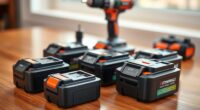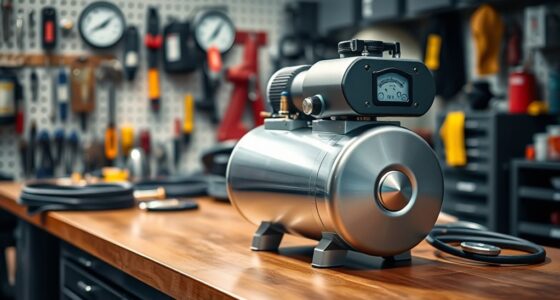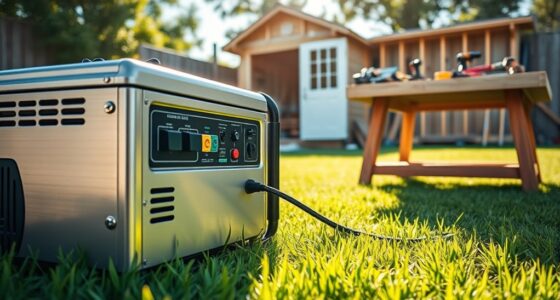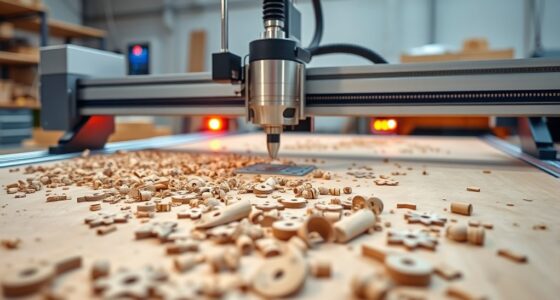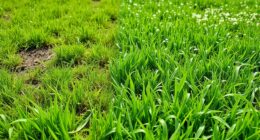Brushless motor technology uses electronic control instead of brushes to switch current in the stator, creating magnetic fields that spin the rotor with permanent magnets. This design improves efficiency, reduces noise, and extends lifespan. You’ll find these motors in drones, electric vehicles, and industrial devices because they offer precise control and reliable performance. To understand how these components work together and what future innovations are emerging, keep exploring more details.
Key Takeaways
- Brushless motors eliminate brushes and commutators, using electronic control to manage current flow and magnetic fields.
- The stator contains windings that generate rotating magnetic fields, interacting with permanent magnets in the rotor.
- Electronic Speed Controllers (ESCs) precisely regulate power, speed, and direction through PWM signals and sensor feedback.
- Advantages include higher efficiency, smoother operation, longer lifespan, and quieter performance compared to brushed motors.
- They are widely used in drones, electric vehicles, industrial automation, and robotics due to their reliability and advanced control capabilities.
The Fundamentals of Brushless Motor Design
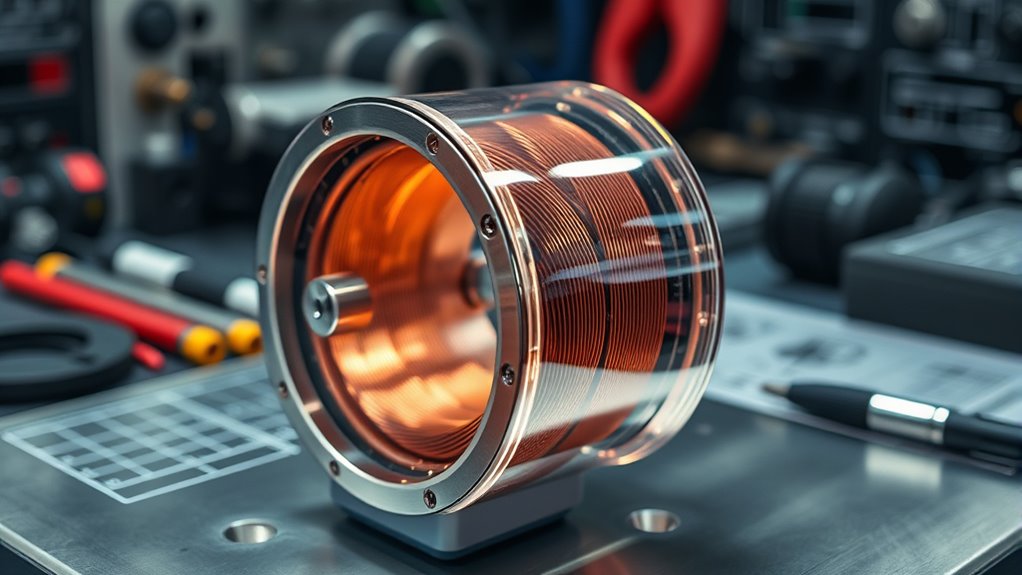
Brushless motors differ from traditional brushed motors primarily because they eliminate brushes and commutators, making them more efficient and reliable. At the core of this design is the stator, which contains carefully arranged windings that generate magnetic fields when energized. These magnetic fields interact with the rotor, creating torque without physical contact. The stator design is vital, as it determines how effectively the magnetic fields are produced and controlled. Unlike brushed motors, which rely on brushes to switch current, brushless motors use electronic controllers to manage the magnetic fields, ensuring smoother operation and less wear. This efficient stator design leads to higher performance, longer lifespan, and better energy utilization, making brushless motors ideal for modern applications requiring durability and precision. Additionally, the use of cooling mechanisms in some brushless motors helps maintain optimal operating temperatures, further enhancing their longevity and efficiency.
How Brushless Motors Operate
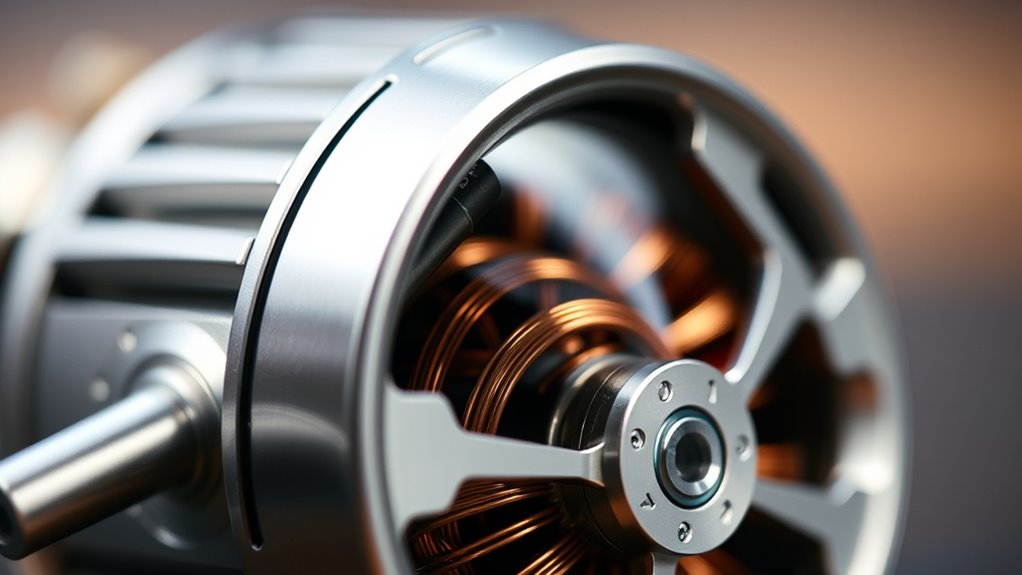
To understand how brushless motors operate, it’s important to recognize that their control system directs electric current precisely to generate rotating magnetic fields. These magnetic fields interact with the rotor, influencing its dynamics and causing it to spin without physical brushes. The electronic controller switches the current in the stator windings, creating a continuous magnetic loop that pulls the rotor along. Key aspects include:
Brushless motors use controlled magnetic fields to spin the rotor without physical brushes.
- Precise control of electric current
- Generation of synchronized magnetic fields
- Elimination of brush wear
- Improved efficiency and lifespan
- Smooth rotor movement driven by magnetic interactions
This process ensures consistent rotation and torque, leveraging magnetic fields to control rotor dynamics efficiently. Your understanding of this operation helps highlight why brushless motors are so effective in various applications. Additionally, the design often includes advanced cooling systems to maintain optimal performance during prolonged use.
Advantages Over Traditional Brushed Motors
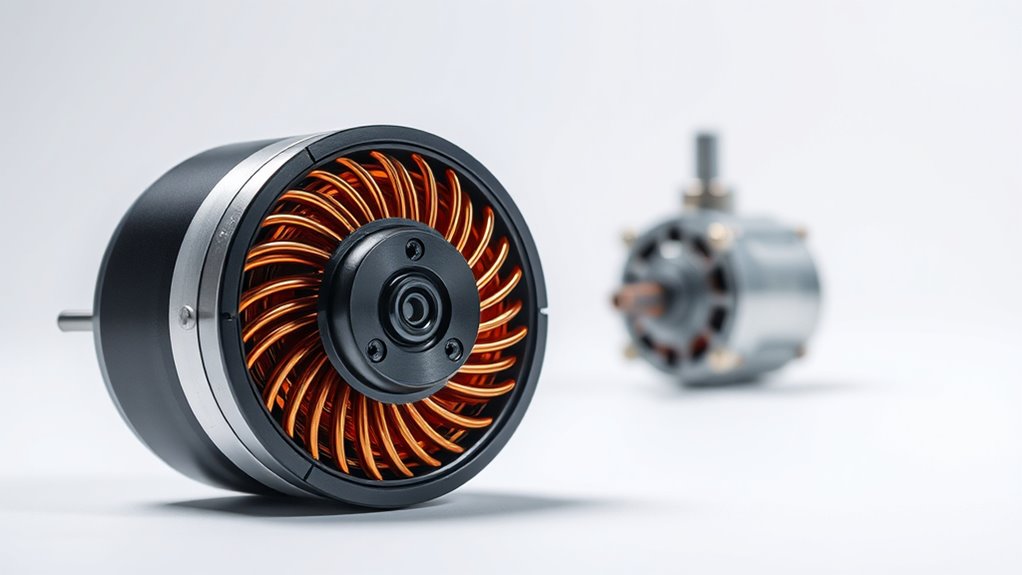
One of the main advantages of brushless motors is their increased efficiency compared to traditional brushed motors. Because they use electronic commutation with sensor integration, you experience smoother operation and better control. This setup minimizes energy loss, making the motor more power-efficient and prolonging battery life in applications like drones or electric vehicles. Additionally, sensor integration helps reduce noise and vibration, resulting in quieter operation. Unlike brushed motors that generate brush wear and electrical sparks, brushless designs are more durable and require less maintenance. Their precise control also improves performance consistency. Moreover, gear shifting in bicycles demonstrates how precise electronic control can optimize performance. Overall, these benefits make brushless motors a superior choice for many modern devices, offering higher efficiency, quieter operation, and longer lifespan compared to traditional brushed motor systems.
Components and Construction of Brushless Motors
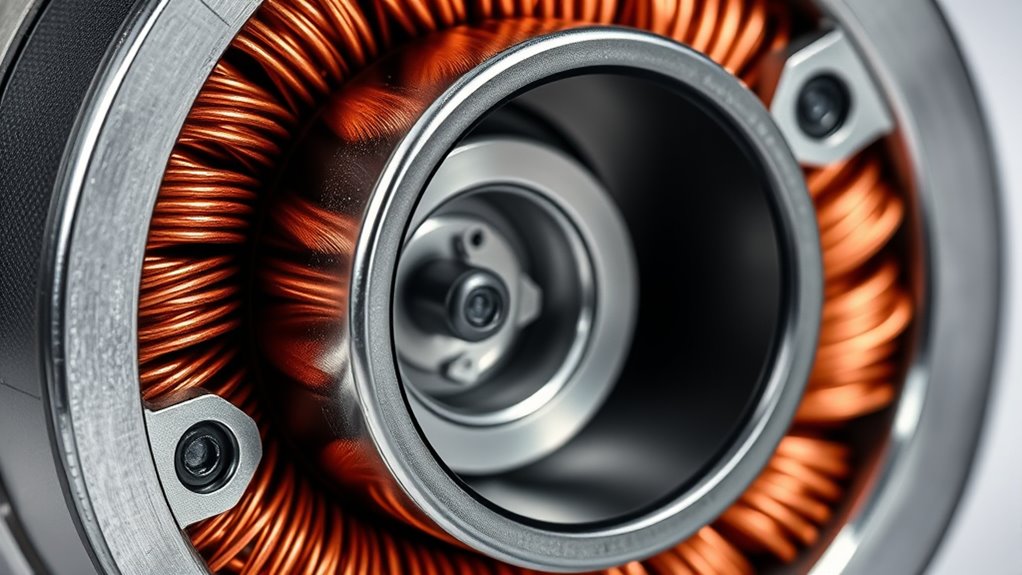
Understanding the components and construction of brushless motors reveals how they achieve their high performance and durability. The main parts include the rotor, which contains magnet types like permanent magnets, and the stator, featuring a carefully designed stator design that improves efficiency. The stator consists of coils and iron cores that generate magnetic fields when energized. Key features include:
- Magnet types: Neodymium, ferrite, or ceramic magnets for strong magnetic fields
- Stator design: Optimized coil arrangement for better torque and efficiency
- Cooling system: Ensures consistent performance and longevity
- Bearings: Reduce friction and wear
- Housing: Protects internal components and maintains structural integrity
This construction guarantees high reliability, efficiency, and long-lasting durability in various applications, emphasizing the importance of magnetic field generation in achieving optimal motor performance.
Common Applications and Use Cases
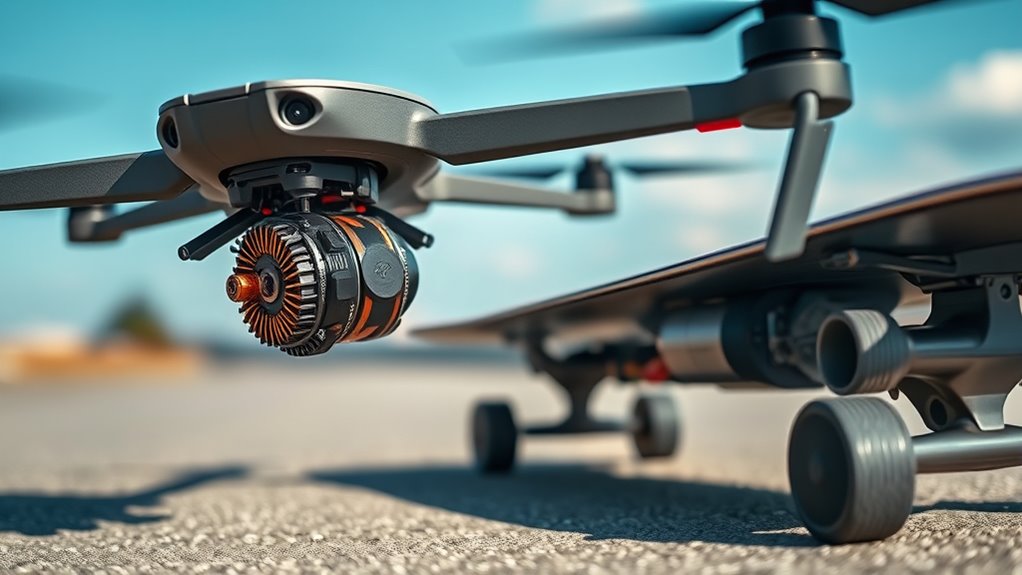
Brushless motors have become essential across a wide range of industries due to their high efficiency, reliability, and compact design. In industrial automation, you’ll find them powering robotic arms, conveyor belts, and CNC machines, where precision and durability are paramount. They help streamline production, reduce maintenance, and improve overall efficiency. In consumer electronics, brushless motors are common in devices like drones, electric toothbrushes, and camera gimbals, providing quiet operation and long-lasting performance. Their lightweight and compact nature make them ideal for portable gadgets and high-performance tools. Additionally, ongoing innovations in heat pump technology continue to enhance motor performance and energy efficiency, further broadening their application scope. Whether in industrial settings or everyday electronics, brushless motors enable smoother operation, lower energy consumption, and increased lifespan, making them a versatile choice for a broad array of applications.
Controlling and Driving Brushless Motors
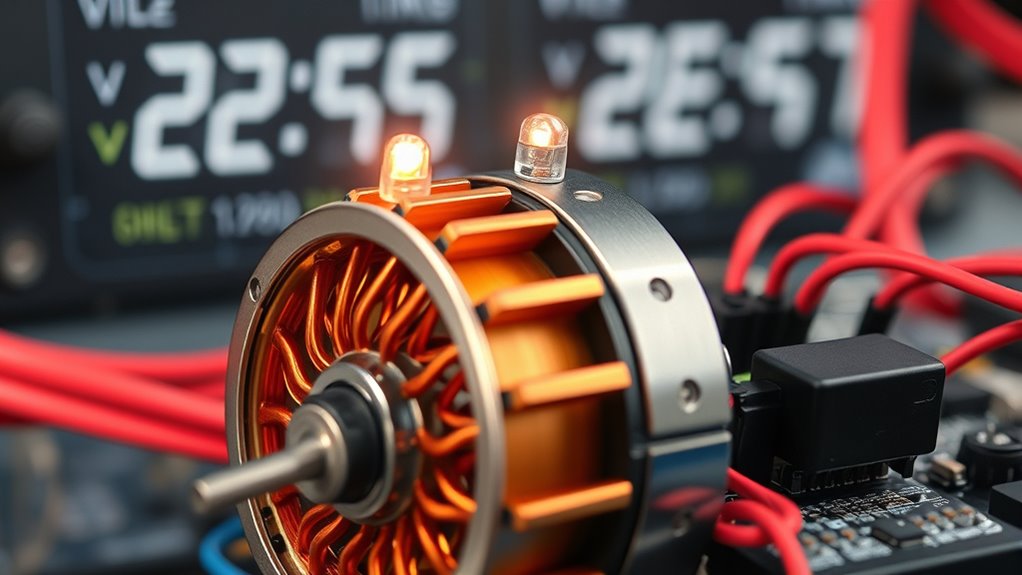
To control and drive brushless motors effectively, you’ll rely on electronic speed controllers (ESCs) that manage power delivery. These ESCs use PWM signals to adjust motor speed precisely and make certain smooth operation. Mastering PWM signal management is key to optimizing your motor’s performance and responsiveness. Additionally, understanding the electronic speed controllers that regulate power is essential for ensuring reliable and efficient motor control.
Electronic Speed Controllers
How do electronic speed controllers (ESCs) effectively manage the operation of brushless motors? ESCs regulate speed, direction, and braking by converting battery power into precise electrical signals. They use sensor calibration to guarantee accurate rotor position detection, which is crucial for smooth operation. Proper thermal management prevents overheating, extending component lifespan. Key features include:
- Precise control of motor speed and torque
- Sensor calibration for accurate rotor positioning
- Thermal management to avoid overheating
- Overcurrent and voltage protection
- Programmable settings for custom performance
- Kia Tuning techniques can optimize motor performance and longevity.
PWM Signal Management
Have you ever wondered how PWM signals effectively control the speed and torque of brushless motors? Pulse Width Modulation manages motor performance by adjusting the power delivered through precise signal timing. Proper sensor calibration ensures the controller accurately detects rotor position, enabling smooth commutation. This calibration is crucial for ideal response and efficiency. As the motor operates, thermal management becomes critical; excessive heat can degrade components and disrupt PWM control. By monitoring temperature sensors, you can adjust PWM duty cycles to prevent overheating, maintaining consistent performance. Effective PWM signal management balances power delivery, preserves motor longevity, and ensures responsive operation. Mastering this control method allows you to fine-tune your brushless motor’s behavior, achieving optimal performance while safeguarding against thermal-related issues. Additionally, understanding the sensor calibration process helps ensure precise commutation and efficient operation.
Future Trends and Innovations in Brushless Motor Technology
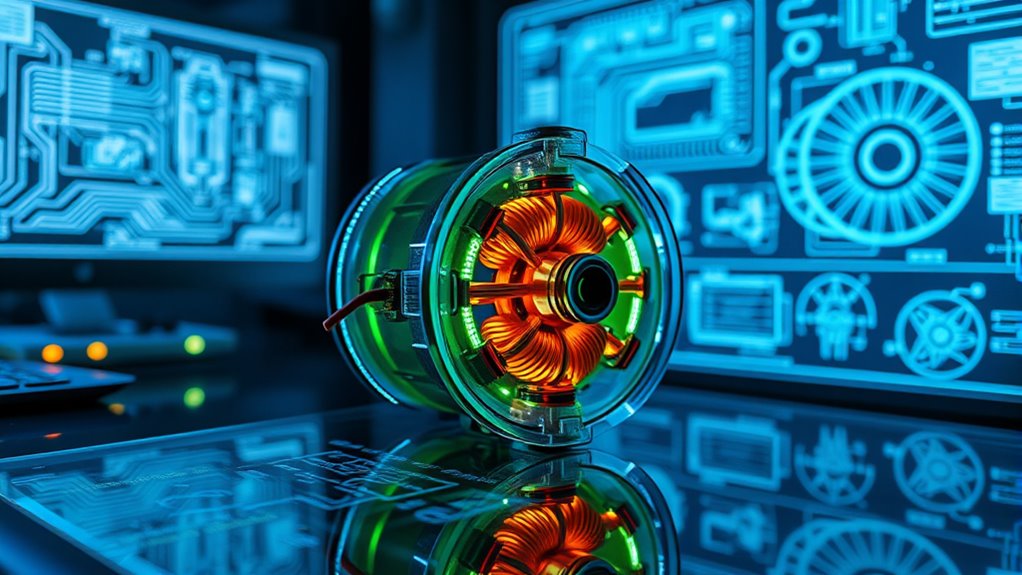
Future innovations in brushless motor technology focus on boosting efficiency and smarter control systems. You’ll see more integration with AI to optimize performance and reduce energy consumption. These advancements will make brushless motors more adaptable and sustainable for a variety of applications. Additionally, ongoing research and development in chemical materials will enhance motor components, leading to longer-lasting and more environmentally friendly solutions.
Enhanced Efficiency Methods
What innovations are driving the next wave of efficiency improvements in brushless motor technology? Advances focus on optimizing thermal management and noise reduction. Improved cooling techniques prevent overheating, ensuring consistent performance and longer lifespan. Noise reduction methods, like precision engineering of components and better balancing, minimize vibrations and sound. Additionally, enhanced magnetic materials boost efficiency by reducing energy losses. High refresh rates contribute to smoother operation and better responsiveness in motor applications. Consider these key strategies:
- High-performance cooling systems
- Precision winding techniques
- Use of rare-earth magnets
- Vibration damping components
- Optimized motor design for quieter operation
These innovations work together to maximize efficiency, reduce energy waste, and improve overall performance. As a result, future brushless motors will be more reliable, quieter, and capable of handling higher loads with less thermal stress.
Integration With AI
Advancements in thermal management and noise reduction set the stage for smart integration of artificial intelligence into brushless motor systems. AI integration allows your motor systems to optimize performance dynamically, adapting to changing conditions in real-time. With predictive maintenance, AI can analyze data from sensors to identify potential issues before they cause failures, reducing downtime and repair costs. You’ll benefit from smarter diagnostics and more efficient operation, extending the lifespan of your motors. As AI algorithms become more sophisticated, they’ll enhance control precision, energy efficiency, and system responsiveness. Material durability improvements also support the reliable functioning of AI-enhanced systems in diverse environments. This integration paves the way for autonomous operation, greater reliability, and innovative applications across industries. Embracing AI in brushless motor technology positions you at the forefront of future-proofing your systems and maximizing performance.
Frequently Asked Questions
How Do Temperature Variations Affect Brushless Motor Performance?
Temperature variations considerably impact your brushless motor’s performance through thermal effects. As temperatures rise, the motor’s efficiency decreases, and overheating can cause damage. Conversely, low temperatures may reduce lubrication effectiveness. To maintain ideal operation, you need effective temperature management strategies like cooling systems and proper ventilation. Monitoring thermal effects helps prevent overheating, ensuring your motor runs reliably and prolongs its lifespan, even under varying environmental conditions.
What Maintenance Is Required for Long-Term Brushless Motor Operation?
To guarantee long-term brushless motor operation, you should follow regular maintenance routines. Keep an eye on lubrication schedules to prevent friction and overheating, and perform bearing inspections to catch wear early. Clean the motor components periodically to remove dust and debris, and check electrical connections for corrosion or looseness. Proper maintenance helps extend the motor’s lifespan, maintain efficiency, and prevent unexpected failures.
Are There Environmental Concerns Related to Brushless Motor Manufacturing?
You should consider the environmental concerns related to brushless motor manufacturing, such as the use of eco-friendly materials and recycling practices. Manufacturing processes may involve rare earth metals, which can impact ecosystems if not responsibly sourced. Promoting recycling practices helps reduce waste and environmental impact. By choosing manufacturers committed to sustainable practices, you can guarantee that the production of brushless motors aligns with environmental conservation efforts.
How Do Different Motor Controllers Influence Efficiency?
Different motor controllers substantially influence efficiency by optimizing power management and controlling current flow. When you choose a controller with high controller efficiency, it reduces energy losses, ensuring more power reaches the motor. This leads to better performance and longer battery life. Effective controllers manage power dynamically, adjusting to load conditions, which enhances overall efficiency. Your selection of the right controller impacts operational costs and sustainability, making it a vital decision in motor system design.
Can Brushless Motors Be Easily Retrofitted Into Existing Systems?
Think of retrofitting brushless motors as fitting a new puzzle piece into an old puzzle. You might face retrofit challenges like mounting differences or power supply compatibility considerations. While some systems are designed with adaptability in mind, others require significant modifications. To facilitate a smooth transition, assess your existing setup’s specifications and compatibility before swapping in a brushless motor, making sure the upgrade doesn’t turn into a piece that doesn’t quite fit.
Conclusion
So, after all this talk about the fancy, high-tech brushless motors, you’d think they’re just perfect. But don’t forget, behind their sleek design and clever control, they’re still just tiny electric engines trying to do their job. Ironically, the more advanced they get, the more you realize how much we rely on these silent workhorses, quietly powering your gadgets while you marvel at their sophistication. Sometimes, simplicity really is the best—until it’s not.

